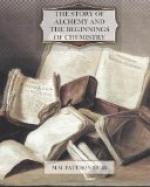Let us suppose that the transformation of one element into another element or into other elements has been accomplished. Let us suppose that the conception of elementary atoms as very stable arrangements of many identical particles, from about a thousand to about a quarter of a million times lighter than the atoms, has been justified by crucial experiments. Let us suppose that the conception of the minute grains of radio-active substances as particular but constantly changing arrangements of the same identical particles, stable groups of which are the atoms of the elements, has been firmly established. One result of the establishment of the electronic conception of atomic structure would be an increase of our wonder at the complexity of nature’s ways, and an increase of our wonder that it should be possible to substitute a simple, almost rigid, mechanical machinery for the ever-changing flow of experience, and, by the use of that mental mechanism, not only to explain very many phenomena of vast complexity, but also to predict occurrences of similar entanglement and to verify these predictions.
The results which have been obtained in the examination of radio-activity, of kathode rays, of spectra at different temperatures, and of phenomena allied to these, bring again into prominence the ancient problem of the structure of what we call matter. Is matter fundamentally homogeneous or heterogeneous? Chemistry studies the relations between the changes of composition and the changes of properties which happen simultaneously in material systems. The burning fire of wood, coal, or gas; the preparation of food to excite and to satisfy the appetite; the change of minerals into the iron, steel, copper, brass, lead, tin, lighting burning and lubricating oils, dye-stuffs and drugs of commerce; the change of the skins, wool, and hair of animals, and of the seeds and fibres of plants, into clothing for human beings; the manufacture from




